#fossils pre 2017
Explore tagged Tumblr posts
Text




Some already brought echinodem regularis petriefied flint sea urchin cores with ammonites on plain white background.
Again i like to share them here to seen for others too.
2 notes
·
View notes
Text
Affordable insurance in high-risk areas, heatwave-proof housing and different work schedules are among dozens of new measures. France is preparing for a future where global heating has risen to 4C above pre-industrial levels, sparking more wildfires and eroding its coastlines. The government unveiled its third national climate adaptation plan yesterday (10 March), outlining dozens of measures to protect citizens in a possible 4C by 2100 scenario. First shared by former Prime Minister Michel Barnier in October last year, the plan received almost 6,000 contributions during a public consultation, and has been developed with scientists and other experts. "Adapting is not giving up," Agnès Pannier-Runacher, France’s minister of ecological transition, biodiversity, forests, the sea and fisheries, made clear when announcing the plan on social media site X yesterday. “The government's policy rests on two legs: on the one hand, it continues to reduce greenhouse gas emissions, on the other, it adapts to the effects of climate change.” France is aiming to reach carbon neutrality by 2050, having already seen its emissions drop by 20 per cent since 2017, according to Pannier-Runacher. But even if net zero is achieved by mid-century, scientists still predict temperatures in the country will climb by at least 4C by 2100 due to the continued impacts of burning fossil fuels.
continue reading
I don't know how you'd plan for a 4C world. We can't even plan for the 1.5C we already have.
8 notes
·
View notes
Text


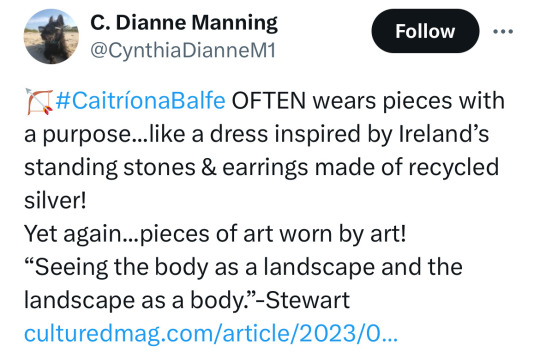
Twitter
Everything You Need To Know About Standing Ground, the British Brand Making Time-Traveling Garments
Ahead of his London Fashion Week show, the designer offered a look inside his sculptural fashion label, built on Irish mysticism, fantasy classics, and an intuitive approach to craft
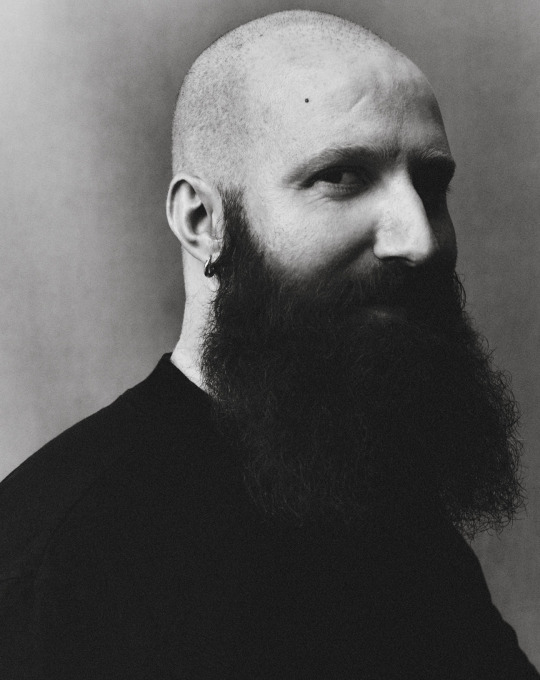
Ireland’s standing stones, or dolmens, are the oldest remaining neolithic monuments in the country. For Michael Stewart, the designer behind London-based label Standing Ground, they are portals through time: stoic witnesses to the eons. He recalls taking frequent trips to visit them as a child, enchanted by the centuries-old mysticism buried deep within. “Ireland is a superstitious country, which is a good thing, because the dolmens have been preserved and protected over time,” he muses. “They’re feared in a way, so people don’t dare touch them.”
It’s no secret that Stewart’s spiritual connection to these megalithic tombs informs his brand’s name and modus operandi. Speaking from his new studio at the Sarabande Foundation in East London, he explains that the dolmens possess a transcendent quality, which he projects onto his own statuesque garments: deceptively simple creations that borrow from the futurism of sci-fi and fantasy classics such as Lord of the Rings to imagine evening wear, custom garments, and body ornaments that feel rooted in neither past, present, nor future.


After graduating from the Royal College of Art in 2017, Stewart established Standing Ground in 2022, before attracting the attention of Lulu Kennedy’s Fashion East incubator program, and making his London Fashion Week debut as part of the Spring/Summer 2023 shows.
Remaining loyal to his source material of neolithic artifacts and figures—images of a dolmen and a Saint Brigid’s cross adorn his spare studio walls—he doesn’t have a mood board or sketches, and freely admits to having done no new research since his master’s degree. Instead, Stewart takes an intuitive, and manual, approach to draping, sculpting, and craft, developing his own lines and patterns by hand to produce alien silhouettes that flow from and protect the body like topographic armor.

Stewart is currently working on his third collection for Spring/Summer 2024, which expands on the dialogue between distant pasts and otherworldly futures. “It’s different to what I would’ve presented last February, which was very beautiful, but not as menacing,” he confesses. “I wanted to take some time to figure out what I was doing, and not pigeonhole myself.”
This collection dials back the clock to pre-human times, focusing on primordial, skeletal, and fossilized forms to create uncanny garments that explore the relationship between objects and their surrounding environment. Imagining a world where ancient objects grow and shapeshift across each collection, the designs suggest a speculative place where humankind and nature are mirrors for each other—or, as Stewart puts it: “seeing the body as a landscape and the landscape as a body.”
Makeup by Machiko Yano / Hair by Moe Mukai / Casting by AAMØ Casting / Model is Nyaueth Riam / Fashion Assistance by Florence Thompson / Makeup Assistance by Krishna Branch-Mackowiak
Cultured
Brian’s Note: Cultured magazine’s story was published last year on 15 September. It mentions “Stewart is currently working on his third collection for Spring/Summer 2024.” Some of the dresses included in that collection are the dress Caitríona wore to the IFTAs and the ones below.



Instagram
Remember… Ireland’s standing stones, or dolmens, are the oldest remaining neolithic monuments in the country. ☘️
#Tait rhymes with hat#Good times#Fashion#IFTA Awards#20 April 2024#Dublin#Cultured#15 September 2023#Thanks thetruthwilloutsworld
32 notes
·
View notes
Note
Give me as much information about the super epic shark Megalodon as much as you can I need it for school for real!!!
Megalodon Facts!
Hi and thanks for your question! megalodon is pretty well known but here are some more obscure facts I found that will hopefully help!
Megalodon teeth were used by a variety of pre-contact cultures in North America. It is thought that they were valued artifacts and/or that they were modified to be used as weapons. Megladon teeth were mined from Chesapeake Bay and traded with other cultures nearby.
Megalodons used to be classified in the same genus as Great white sharks (Carcharodon) because of the similarities between their teeth. The current model is that Megalodon belongs to the Otodus genus and the similarities between its teeth and Great white sharks is a case of convergent evolution making them appear similar. They (megalodons and great white sharks) would still probably look somewhat similar based on how we have interpreted other ancient sharks and their similarity with modern lamnids such as great white sharks.
They were also widely distributed, with fossils being found all over the world. Based on where we have found megalodon teeth we can infer its tolerance of environmental temperatures is between 1-24 C (34-75 F). They where probably able to handle such cold temperatures because they were mesotherms. That is when an animal isn't quite an endotherm (able to create our own heat) but isn't an ectotherm (can't regulate their body temperature like most snakes for example). They had the ability to affect their body temperature via their metabolism but when the temperature in the environment is decreased their body temperature will also decrease. It is also thought that as body size increases in mesotherm animals there body temperature increases because of the square cube law. It is hypothesized that one of the reasons megalodon was so large. (you can read more in the article cited below).
Also megalodons have gone extinct no matter what the discovery channel says
Hope this helps!!
Sources bellow:
-------------------------------------------------------
papers:
Lowery, Darrin, et al. “INTEGRATED GEOLOGY, PALEONTOLOGY, AND ARCHAEOLOGY: NATIVE AMERICAN USE OF FOSSIL SHARK TEETH IN THE CHESAPEAKE BAY REGION.” Archaeology of Eastern North America, vol. 39, 2011, pp. 93–108. JSTOR, http://www.jstor.org/stable/23265116. Accessed 27 Feb. 2024.
Farrell, A. D. (A. D. ). A Use-Wear And Functional Analysis Of Precontact Shark Teeth Assemblages From Florida. no date. Florida State University, 2021.
Ferrón, Humberto G. “Regional endothermy as a trigger for gigantism in some extinct macropredatory sharks.” PloS one vol. 12,9 e0185185. 22 Sep. 2017, doi:10.1371/journal.pone.0185185
links:
8 notes
·
View notes
Text
Build Up, Episode 2: Tomboy (Hyukoh)

Welcome back to my extremely timely recaps of Build Up, the MNET vocal survival show thing! In the previous post, we covered Shall I...? and Ditto. In this one, we'll continue with the Pre-4 mission by covering the performance of Tomboy, originally by Hyukoh. Let's go!
Hyukoh is a Korean band fronted by their lead singer and songwriter, Oh Hyuk. They do sort of alt-rock stuff, and they’re pretty popular. Tomboy was a pretty big hit for them in 2017.
Sample lyrics: Sad adults always only walk backwards / You, who just passed your Terrible Twenty, look bored / Because we don’t want to be set on fire and burn quickly / We’re cheering for love… The young us / We can’t see our tree rings / Our eyes are getting blind from the bright lights
I know Oh Hyuk mainly from a song I really love by Code Kunst called Parachute, which features him. (If a song by Code Kunst “features” someone, it means that person sings the whole song.) It’s a really great song, kind of special in my opinion, so do check it out if you have a few minutes. Oh Hyuk has a gruff, textured kind of voice, quite distinctive, and very much in the vein of the voice of our leather jacket king, Lee Gwangsuk.
The judges are excited, because they like this song, as do the boys backstage, who think that the team who chose this song are well suited to it. And who is that team?
It’s Lee Gwangsuk, Park Joohee, Hwang Inhyuk, and Jo Hwanji.
The judges notice right away that Jo Hwanji is wearing a uniform. He salutes, saying “Victory!” and Eunkwang, who already did his military service, immediately returns the salute. Hwanji introduces himself as Sgt Jo Hwanji, currently serving in the Air Force Military Music Honor Battalion. I tried to look up info on this, like, does he have to appear in uniform? What the heck is a Military Music Honor Battalion? What is going on? No clue, my friends. My google skills only take me so far. If you have info to share, I’d be happy to take a look at it.
Inhyuk is wearing a sweater that appears to say “Sensitive People Fragile Club,” and honestly, same. I mean, I’m not wearing the sweater, but it’s implied.

He has a pleasant speaking voice, and says he’s looking to be the “main vocalist of Build Up”
Park Joohee says he’s the maknae (youngest) of the whole show, and everyone cooes over him a bit. He says he already got into college, and he gets some congratulations from the judges.
This part was a little confusing, so I watched it a few times before I figured it out. Some of the contestants backstage say he’s the same age as them, including Detective Donghun from A.C.E., who I know was born in 1993 and is definitely not 18! Then someone else says Year of the Rooster, and I figured it out -- if you’re born in 1993 or 2005, you’re born in the Year of the Rooster, and that makes you akin from a certain perspective. It might be like in Western culture when people say something like “oh, yeah, fellow August baby here…” It’s been my experience that people who live in cultures that celebrate Lunar New Year tend to just know what year was what animal. The owner of a little B&B I stayed at in Cambodia guessed the year I was born using a combination of my basic appearance and my Chinese zodiac sign. So yeah, the moment they knew Joohee’s age, they knew his zodiac sign and then knew if they were the same as him. I don’t claim that this kind of thing is universal amongst all people in Asian cultures, but I’ve encountered it enough times to think that it must not be unusual. Again, if you have info to share or if I got that wrong somehow, please let me know, but be nice! Thanks, friends! Thriends.
Joohee jokes a bit with the judges, and it turns out that he’s going to be going to the same college as the one that Jaehwan went to (I think). He’ll be class of ‘27, while Jaehwan is class of ‘19. The other judges call him an ammonite (fossil).
Gwangseok says hello, and everyone is surprised at how deep his speaking voice is. He introduces himself as a freelance model who wants to make people fall in love with his voice.
The judges say, “ohhhh!”

(Model?)
We get to see his modeling profile and it turns out he’s 188 cm tall, making him 6’2. The judging panel jokes that it’s not fair that he can sing when he’s that tall.
We’re reminded of his unique voice from the vocal check in, and how he got to pick first. Everyone applauded when Gwangseok chose Tomboy, as it suits his vocals. Inhyuk in 11th place was next to join, then Hwanji in 16th place, and then Joohee in 24th place, making this song one of the first songs to fill up completely.
We find out that Joohee idolizes Inhyuk from the time that Inhyuk went on I Can See Your Voice. Joohee approaches Inhyuk and tells him as much, which of course absolutely warms Inhyuk’s heart.

“REALLY?” Joohee (back to us) approaches Inhyuk as pink haired Geonu looks on.
Inhyuk interviews that there are people here who are a lot more famous than he is, so he was really touched and he wants to take care of Joohee. Inhyuk chooses Tomboy partly to be with Inhyuk, but also because that was the song he really wanted.

So how should this team with all four vocal colors distribute the parts?
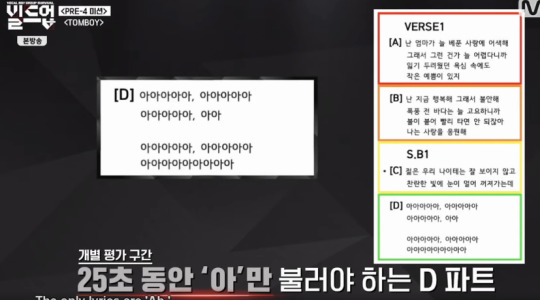
Nobody wants part D, which is just “ah ah ah ah” for 25 seconds. It’s like when you do Me and Bobby McGee for karaoke and have to do two minutes of “ladedada.” But on further reflections, Gwakseong decides that the “ah” part is the core of the song, and that it might sound cool if he sings it with a scratchy voice.
A few days later, they meet up somewhere.

Left to right: Inhyuk, Joohee, Gwakseong , a pile of leaves and twigs
Aside from Hwanji, they’re all rocking sweaters. You guys, this is the show of sweaters. Inhyuk spent some time on his own to create some layered harmonies and even recorded them so they could all hear them. They practice singing together, with Inhyuk providing advice and encouragement to maknae Joohee. Throughout we do not hear Hwanji speak even once.
The performance begins.
Link for the version without reactions

LTR: Lee Gwangsuk, Park Joohee, Hwang Inhyuk, Jo Hwanji
My thoughts:
Overall, this was an excellent performance and I could imagine it being a lot of people’s absolute favorite. For whatever reason, it’s not perfectly ringing my bells and I think it comes down to taste and the song itself. This song probably relies a lot on the meaning of the lyrics and since I don’t understand them intuitively it’s not as fascinating to me. Also, it feels like it should be in a faster tempo and like someone just set it on slow. Just my take; sorry if it’s your favorite!
All four vocalists were really good and all of them sing better than I do, so please forgive me as I nitpick a bit, ok? They all did great but I have opinions. Okay!

LTR: Lee Gwangsuk, Hwang Inhyuk
In my initial write up, I wrote that Gwangseok has a unique, smokey, extremely thick kind of voice that some people might like and others might not. I like it, though I wondered if it would work well in a vocal group that required blending of voices. In this performance, I was able to see how he could fit in as a member of a group, as his voice really could blend in quite nicely. I felt a little like he was trying a tiny bit too hard on the “ahhs”, but maybe I’d feel different if I understood the lyrics and was really jiving with the emotion of the song. His belts toward the end felt a bit strained, and I think that’s his lack of training showing. He still has a really interesting, distinct voice and I could see him going far.
In my initial write up, I noted that Inhyuk had a really unique voice and thought he shouldn't have classified himself as an Allround. I liked his soft, almost gruff voice, but noticed some problems with his belts. I felt like somehow this wasn’t the best he could do and decided to reserve judgment. In this performance, his belts sounded a lot better and I think I was right, that he was capable of doing better than he did in his teaser. I also loved how he sounded in the bridge. A voice like that could go either way but I ended up really liking it, especially in that part in the bridge when he had the spotlight on him. He has a slight sharp edge to his voice that makes him not my absolute favorite among these four, but I still liked what he did a lot, and I find him personally appealing for some reason. Also I like his delivery where he seems to be almost talking, and I really like the beautiful harmonies that he arranged. Nice work, Inhyuk!

LTR: Park Joohee, Jo Hwanji
In my initial write up, I noted that Joohee had a pleasant voice with good agility, though he lacked breath support. In this performance, I really loved his full, open sound, and he ended up being easily my favorite of the four. His voice is a bit similar to Inhyuk’s but without the sharpness, so it just makes it all the more easy to listen to. I still think he needs to work on his breath support, though. Some notes of his should have been held for another half a second. He was still my favorite, though. I just love his vocal color.
In my initial write up, I said that Hwanji broke the musical actor mold by singing in a clean, full voice. I noted his varied dynamics, impeccable pitch, and power. In this performance, I didn’t love how he sounded in the opening lines. Maybe the trembling, half-voiced effect was what he was going for, but for me it sounded like a mistake, like he needed to clear his throat but didn’t have time. He seemed to be running out of breath, too. Maybe he’s not great at singing softly, since “power” is his strength. Despite that not-great opening, he was better in the rest of the song, and his harmony with the others was gorgeous throughout. It’s not easy to harmonize well, and he really did.
In fact, the harmonies overall were really lovely. At times, they didn’t quite blend dynamics as well as they could have -- I think it was Gwangseok’s fault, though I might be wrong -- but the actual notes they were singing were amazing.
If I had to pick a top tier, it’d be Joohee, and I think my bottom tier would be Hwanji, but I’m sad about it because I really loved his teaser performance. Maybe it was an off day for him or maybe he just should have picked a different song. Also, it’s not like he did badly. This would just be my least favorite of the four, not my least favorite singer of all time. I’m still looking forward to hearing what he sings next time!
In the MNET edit, the judges are shown loving everything, even Hwanji’s opening and Gwangseok’s too emphatic “ahhs”. They even show Dahee grinning. Everyone loves the performance.
When they’re done, the judges lavish praise on them. Eunkwang says that they have different vocal colors, but “the emotional line that the four of had together was aligned, so it was different but harmonious.” Baekho says that each time they changed from singer to singer, it was cathartic, hearing a different voice coming in. I know what he means -- I love how I know all of Exo’s voices and being able to say, oh, that’s Xiumin, oh, that’s Chanyeol, oh, here comes Chen, aw, it’s Kai… like that. It almost makes it boring in comparison to listen to a song that only one person sings.
Vocal Coach Guy (VCG) praises Gwangseok’s “tone that was never taught.” He was born with a tone that can express so much depth just by singing “ah.”

Vocal Coach Guy likes Gwangseok’s tone. I think? I guess? Not sure.
Solar says that Joohee sounds like a “church oppa,” with his sweet, clean voice. She also loved his smile.

Joohee, looking divine.
Solar says that VCG is also a church-oppa type, and VCG says “shalom, shalom,” which if you don’t know is Hebrew, so more appropriate for Temple than for Church, so that’s pretty funny.

Solar is so happy it’s made her cold!
Then Eunkwang points out that Inhyuk is the one who arranged all the harmonies, and everyone correctly praises him for working out such a lovely arrangement.
The judges say it’ll be difficult to pick a Top Tier, and the guys back stage seem to think it’ll be any of Gwangseok, Inhyuk, or Joohee. VCG says that he wishes that Hwanji would just do a traditional ballad, and weirdly enough, I think I agree.
Who wins top tier?

COMMERCIAL!
BACK FROM COMMERCIAL!
The judges have voted!
Baekho voted for Jo Hwanji, VCG voted for Hwang Inhyuk, and everyone else voted for Park Joohee. Ouch for Gwangseok that no one voted for him, but he did come in first in the vocal check so he can’t feel that bad.

Dahee prompts the older members to say something nice to Joohee, and they all tell him they love him. It’s cute. They leave the stage arm in arm.
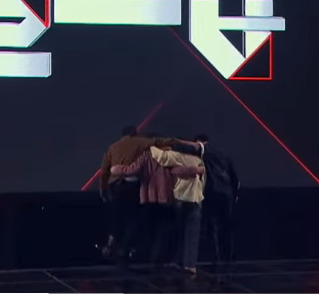
Ok, so that I can keep putting in as many pictures as I want to, I’m going to just go ahead and post this now. In the next one, we’ll be covering “Something Like That.” Thanks as always for reading. You're my Valentine for sure! <3
See you in the next one!
3 notes
·
View notes
Text
Paying for Progress or Nothing
Journal 4: The Implications of Train Law to the Life of Juan Dela Cruz

I remember the Juan dela Cruz show that featured CoCo Martin as a kid, I always watched that show after school because he has this cool weapon that is a cross, he is half aswang that tries to kill evil monsters. But also, a model filipino citizen that has consciousness and feelings for other living things even if they are evil.
Why am I mentioning this? Well when it comes to an everyday filipino, there comes the time where we want to improve our everyday lives. That’s where taxes come in, we pay them in order to develop our government and revenue like good healthcare, education, and a lot more services to help the people.
Sounds like a good plan right? But somehow it isn’t. I mean, how does a filipino know that their money is in the right hands? How do we know that what they’re doing is for the benefit of our development? And how do we know that this won’t affect us badly in the end? When it comes to laws that changes to make somethings simpler, there won’t be any guarantee if those changes will be good or bad. But we still somehow try to give because if we didn’t, there wont be any change at all in our lives or worse we get in very bad trouble.
What do I Know? (Learning)
In the Philippines, there is a reform called the Tax Reform for Acceleration and Inclusion or the Train Law signed by Rodrigo Duterte somewhere in 2017, which is also the first package of the Comprehensive Tax Reform Program or CTRP. This is basically where they improve revenue for government projects and services, trying to also make it simpler and fairer. But way back during Pre-Colonial times, this was religiously presented through a kind of offering called “alay” or “handog” to a Datu who is the barangay head. Then when the Spaniards came in, this tax system became a requirement that is called “tributo” or tribute which became a burden for filipino people to carry. After that, the Community Tax Certificate or what we call the Cedula was introduced, which the filipino people compelled to support because of the imperial government. Then when the Ferdinand Marcos Regime was happening, the commencement of the withholding tax by voluntary tax compliance program started. And now, we have technology like E-Vats and EPFS to make it easier for use in modernization.
Besides increasing revenue and making it simpler and fairer, this law aims to be more efficient to create jobs, reduce poverty, and promote investments. TRAIN gives out big income tax cuts for Filipino taxpayers while raising additional funds to support the accelerated spending on infrastructure and service programs. This also focuses on income brackets and personal and excise tax rates, as well as value-added tax coverage. Which pays off many things like sugary beverages like cokes and juices, petroleum products such as gasoline and jet fuels, automobiles, and fossil fuels.
Besides all of the projects, services, and products, how does it benefit the people? Well theres many benefits for everyone.
For people who have a job that pays below ₱250,000 annually will be exempted to pay income tax, to support low income earners by increasing disposable income. For those who earn above ₱250,000, they will pay brackets of 15% to 30% of the excess that they earned which tries to lessen the tax burden or middle income earners while reassuring that people with higher income contributes more percentage of their earnings.
For the many filipinos take-home pay, the individuals who have lower-income have resulted an increase for their net income making their purchasing power increase. Although for higher income earners, they get a decrease of their take-home pay because of the tax brackets. Other benefits for the TRAIN Law are higher tax-exempt bonuses, simplified estate tax, and expanded VAT exemption.
What did I Find? (Observation)
Of course like every law we have implemented, it will always have its negatives. Sure, all of these things about the TRAIN Law sound really great, but were those promises that they said kept? And did this Law really helped the workers, especially the ones who get low income? I mean that’s what it’s aiming for.
Before implementing this law, many theorized that there will be an increase of oil prices and would have a bad effect that would lead to increase on goods and services, especially the delicious sugary drinks, making it bad for consumers especially the lower class. And why is this happening? Because of inflation. Since all of these changes for increasing income and take-home pay, it also has a price that is higher for them to pay off.
This also makes inequality to both poor and rich since a lot of the good stuff are bought by the high incomers since they can afford while the people who have low income can’t even afford the essentials that they really needed for their job like jeepney drivers and taxi drivers who have to pay oil to make their vehicles working. And when things are that highly taxed to get, it makes the main problem that the law was trying to reduce which is poverty.
What do I Think? (Insights)
I had no idea about taxes until now. Sure I’ve heard adults saying that adulting involves taxes which they never tell us what it is actually for. I always thought it was some kind of play money, which is kinda ironically what they’re to our money anyways. But I will say that this TRAIN Law would’ve been better if the things that its says that they would be doing worked. The TRAIN Law is already a train wreck to begin with since this is one of the causes on why inflation has increased in this country. They have been arguing with this back and forth
Sure, this law adjusted the income bracket for individual Filipinos but at what cause? Making things that we enjoy and need high to pay? Making the gap for the poor and rich? Also those aren’t the only things that individuals have to worry about paying for, how about those personal needs like rent, food, water, groceries, and other things? And of course those things will have their prices increased because of our friend, inflation.
To add, a lot of people might not be even aware of these changes of what this law does. Yes, there are seminars from organizations that are willing to teach people how this law does things but that doesn’t really fix the problems that we are facing. Every scenario is different for every Juan or Julianna dela Cruz, and thats why people who are highly affected by this are against it.
Taxation is one of the resilient power that the government has since they involve dictating and manipulating economic growth. The government really relies on taxes to give financial measures to carry its operations and also promoting general welfare. But this makes also the never ending problem of corruption, and that is no stranger to us in the Philippines. And since we have seen these kinds of problems happen before and with that in mind, people don’t really trust this system because of it’s malpractices.
This would’ve still worked if the law just made the taxes for of these products fair for everyone and affordable services like healthcare, education, transportation, and other services that would’ve helped the people. They had an opportunity to make something out of this law because this country is so buried with debt and many or even all of us have to pay for that mistake, but they just keep throwing it over and over again to the point where it makes it worse for all of us.
When I came in to Manila, I expected so many things to be in higher prices because its the city life. And I have lived in the province my whole entire life, and so paying a bottle of water for about ₱40 is shocking to me because isn’t that suppose to be essential? And even the food that is as simple as cafeteria food is something that I am really worried for since those are pricey as well.
Progress is impossible without any changes to the status quo. And increasing something doesn’t mean it’s improving progress because a lot of the time it will just decrease like an ice cube under the hot sun.
REFERENCES:
All aboard: Revisiting TRAIN’s impact on individuals. (2024, August 26). Grant Thornton Philippines. https://www.grantthornton.com.ph/insights/articles-and-updates1/lets-talk-tax/all-aboard-revisiting-trains-impact-on-individuals/
IBON Foundation. (2016, September 3). TAX GANERN! DOF’s tax reforms tax the poor and relieve the rich (Part 2). https://www.ibon.org/tax-ganern-dofs-tax-reforms-tax-the-poor-and-relieve-the-rich-2/
Revisiting the TRAIN Law. (2019, January 15). Grant Thornton Philippines. https://www.grantthornton.com.ph/insights/articles-and-updates1/lets-talk-tax/revisiting-the-train-law/
https://pidswebs.pids.gov.ph/CDN/PUBLICATIONS/pidspn1911.pdf
https://www.researchgate.net/publication/319078695_Unveiling_the_Salient_Features_and_Development_of_Taxation_in_Philippine_History
0 notes
Text

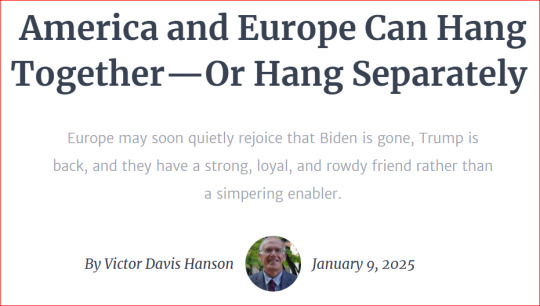
Consider these European and American binaries.
On December 20, 2024, a terrorist, Taleb Al-Abdul Mohsen, rammed his SUV into a Christmas crowd in Magdeburg, Germany. He killed 6 pedestrians and injured 299 others.
Eleven days later, on New Year’s Eve in New Orleans, Louisiana, Shamsud-Din Bahar Jabbar smashed his pickup into a festive crowd. He murdered fifteen and hurt over 35.
Germany’s fertility rate is scarcely above 1.4—about average for a shrinking European Union. About 20 percent of the country is now foreign-born, a record high.
American fertility has precipitously dived to 1.6. The foreign-born now represent 15 percent of the American resident population, the highest in both actual numbers (50 million) and percentages in history.
The German military is a shell of its former self, with fewer than 200,000 soldiers and a shortage of almost all types of weapons.
The U.S. military, after being humiliated in Afghanistan, is currently down some 40,000-plus recruits. It faces shortages of anti-tank weapons, artillery shells, ships, and logistical support.
Germany may finally manage to spend 2% of its GDP on defense; the United States is heading downward below 3%—the lowest in over 80 years since the Great Depression.
Last year, the German economy shrank; this year, it will scarcely grow, in part because of shortages of affordable fossil fuels.
Germans pay four times what Americans on average do for electricity. Yet the Trump administration has promised an oil and natural gas renaissance, hoping to expand both production and exports with envisioned new pipelines and liquefied natural gas terminals.
In sum, the U.S. is beginning to mimic the pathologies of Europe—and yet in the next four years, renewal could help slow the decline of both.
Both face shrinking and aging populations. Both either cannot or will not control their borders, despite popular protests. Both suffer from woke political correctness and are pushing back.
The proverbial people of both nations want smaller government—and more freedom of expression and less woke. They insist on less and legal-only immigration and secure borders.
They vote for cheaper energy and fewer regulations.
Europeans and Americans alike want more meritocracy and fewer fixations on race and gender.
In the chaos of the postmodern 21st century, Europe and the U.S. nevertheless are still likely to share the same enemies and friends.
Both resent the asymmetrical Chinese approach to global commerce, based on a mercantilism that would never allow Europe and the United States to treat China as it does both.
The Europeans and the Americans are both worried about a vastly expanding conventional and nuclear Chinese military.
Neither wants Iran to develop nuclear-tipped missiles with ranges to hit the capitals of both. They do not want Vladimir Putin to recreate the former Soviet Union’s borders.
Europe, as a rule, loves Democrats as kindred quasi-socialists. But privately many Europeans assume their own security and prosperity do better when America is governed by conservatives.
In the past, Europe has not been a fan of Donald Trump, both as president and as a pre- and post-presidency candidate.
They fear that he is an isolationist, insufficiently diplomatic, not fully supportive of NATO, or too tariff-happy for their tastes—and are scared of his art-of-the-deal trolling to prompt wake-up calls.
But 2025 is certainly not 2017 or even 2020. And a “reset” in thinking on both sides is urgently now needed more than ever.
The Biden administration was no model partner for Europe. It quite outrageously forced cancellations of a joint Cypriot, Greek, and Israeli EastMed pipeline to bring much-needed natural gas to Europe.
It talked a great game about strengthening NATO. But the alliance’s bulwark, the U.S. military, saw its real budget cut, its Pentagon politicized, and recruitment short more than 40,000 enlistees.
The humiliating 2021 skedaddle from Afghanistan not only eroded American credibility but undermined all Western deterrence as well.
Biden opposed building new liquefied natural gas export terminals in the U.S. designed to help energy-starved Europe find a reliable and honest supplier and decouple from Russia.
Trump, in contrast, promises to “drill, drill, drill,” in part to ensure needed income by exporting huge amounts of LNG to fuel-starved Europe.
Europe was angry that a bantering Trump once bullied them to meet their promises to increase their defense spending.
But after the invasion of Ukraine, they are happy that some countries did just that.
Europeans likely want—and need—Trump to restore a more deterrent U.S. military, not a woke one.
Europe and America are both in crisis and need radical new thinking.
So, who knows—Europe may soon quietly rejoice that Biden is gone, Trump is back, and they have a strong, loyal, and rowdy friend rather than a simpering enabler.

0 notes
Text
Yves here. We are overdue on giving a full-bore treatment on Project 2025, but this post will hopefully serve as a starting point. Sadly, ambitious and well-organized right wing campaigns to greatly increase the acceptance of their social and policy agenda have proven to be extremely successful, witness the Powell Memo and the Project for the New American Century. Trump is the explicit target of this Heritage Foundation scheme. Because the first Trump presidency was very much a “dog that caught the car” event, Trump had perilous little in the way of plans, and on top of that, weak cabinet members. For instance, Steve Mnuchin’s tax reform plan was an embarrassment, barely rising to the level of a napkin doddle. So after that misfire, the Administration took up the anti-tax lobby’s plan, include their off-the-shelf language. Trump might be a tad better prepared to be President if he wins again, but that does not make him any less receptive to pre-packaged programs from his fellow travelers. So this initiative very much bears watching.
By Diana Cariboni, who started writing for Tracking the Backlash in 2018 and is now openDemocracy’s Latin America editor. She was previously co-editor-in-chief of the IPS news agency and led its Latin America desk for more than ten years. She wrote the book ‘Guantánamo Entre Nosotros’ (2017) and won Uruguay’s national press award in 2018. Originally published at openDemocracy
Last month, populist leaders from around the world gathered for the Europa Viva 24 summit in Madrid. Headlines from the event were dominated by the big names in attendance – Argentinian president Javier Milei, France’s Marine Le Pen, Chile’s José Antonio Kast, and Italian and Hungarian prime ministers Giorgia Meloni and Viktor Orbán – and the fact it ended in a diplomatic row between Argentina and Spain.
But away from all of this noise and fury was a lesser-known speaker: Roger Severino, a former official in Donald Trump’s administration and the vice-president for domestic policy at influential US think tank The Heritage Foundation.
In a six-minute speech delivered in Spanish, Severino described Trump as a victim of lawfare launched by “the lefties” and said young people are subjected to a “culture and a medical system” that tells them to “explore all sexual appetites at age of 10” and that “abortion is not about destroying babies but about healthcare”.
Adding that young people are also taught “that if you are uncomfortable with your sex you were probably born in the wrong body, and surgeries can fix that mistake”, he said: “I’m here to tell you that God doesn’t make mistakes.
Severino is one of the architects of the Heritage Foundation’s blueprint for a second Trump term, named ‘Project 2025’. This aims to reshape the federal state in 180 days, fire tens of thousands of public servants and replace them with people loyal to the conservative cause, undermine the separation of powers, attack public education, and erase or restrict the rights of women, LGBTQ people, workers, migrants and Black people.
It also seeks to dismantle policies to tackle climate change and push for an energy agenda reliant on fossil fuels.
Its plan for doing so is set out in the ‘Mandate for Leadership: The Conservative Promise’, an 887-page playbook published by the think tank, whose mission is “to formulate and promote conservative public policies based on the principles of free enterprise, limited government, individual liberty, traditional American values, and strong national defence”.
It is not absurd to say that some of the Heritage Foundation’s suggestions may well become law if Trump is elected in November. The politically well-connected organisation was founded in 1973 and published its first ‘Mandate for Leadership’ as Ronald Reagan took office in 1981 – later boasting that Reagan had enacted more than 60% of its policy recommendations.
Severino, who was Trump’s director of the Office for Civil Rights at the Department of Health and Human Services, wrote Project 25’s section on health. Of the 199 times the word ‘abortion’ is mentioned throughout the document, 149 are in this chapter, which urges the federal government to remove (or restrict as much as possible) any sexual and reproductive healthcare and rights whose oversight it has responsibility for.
Severino suggests eliminating the approval of abortion pills and banning their distribution by mail; barring the use of federal funds to transport people seeking an abortion in a state where it’s illegal to one where it isn’t; cutting federal funding to Planned Parenthood and other abortion providers; and removing emergency contraception from workers’ health insurance coverage.
In contrast, it’s hard to find any proposals to tackle the US’s real public health crises: opioids, falling life expectancyand rising maternal and infant mortality rates. This is perhaps unsurprising; the Heritage Foundation sees the Supreme Court’s overturning of the 1973 Roe decision that protected abortion up to 23 weeks as a victory – but also as “just the beginning”.
In the two years since Roe’s repeal, 21 states have banned or drastically restricted abortion, and legislative and judicial battles are raging in others attempting to follow suit. But the number of abortions carried out annually has actually increased, according to multiple studies – and so grow the dystopian battleplans for the continued war on reproductive autonomy. Several US cities have made it illegal to use their roads to transport people seeking abortions from a state where abortion is prohibited to one where it is permitted.
Project 2025 wants the Department of Health to go further still, urging it to “protect life, conscience and bodily integrity” and place “strong respect for the sacred rights of conscience” at the top of its agenda. Severino’s chapter calls for legislation requiring states to record data on abortions, including the number of terminations carried out, the reasons for them, the method used, the length of the pregnancy, and the state of residence of the person seeking an abortion.
It also suggests that scientific research conducted with public money should focus on “the risks and complications of abortion” and on “correcting and not promoting misinformation about the health and psychological benefits of giving birth compared to the health and psychological risks of intentionally taking a human life through abortion”.
But Project 2025’s focus isn’t only on reproductive health.
The president who takes office in 2025, the foreword says, must “remove from every existing rule, regulatory agency, contract, grant, regulation, and federal law the terms sexual orientation and gender identity, diversity, equity, and inclusion, gender, gender equality, gender equity, gender, gender-sensitive, abortion, reproductive health, reproductive rights, and any other term used to deprive Americans of First Amendment rights” (which protects freedom of religion, freedom of speech and press, and the right to petition the government for redress of grievances).
The future government must also “immediately cease the collection of data on gender identity, because it legitimises the unscientific notion that men can become women (and vice versa) and encourages the phenomenon of the constant multiplication of subjective identities”, Severino adds.
An Anti-Rights Past and Future
The Heritage Foundation is not the only highly influential institute involved in the writing of Project 25. Of the 100 organisations that sit on its advisory board or directly contribute to the playbook, several have been crucial to the advancement of extremist agenda in the US in recent decades and years.
In 2018, four years before Roe was overturned, Mississippi banned abortions after 15 weeks in the state – with legislation modelled on a bill conceived by the Alliance Defending Freedom (ADF), which the Southern Poverty Law Center lists as an anti-LGBTQ hate group and which sits on the Project 25 advisory board. The law was challenged and stayed by two courts on the grounds that it was unconstitutional because it violated Roe.
The law’s promoters took the case all the way to the Supreme Court, aiming to challenge and ultimately overturn Roe. Their strategy relied on the court having a right-wing majority, which was ensured by Leonard Leo, a conservative lawyer and activist who has founded a network of groups and funding hubs. Leo, who had already been influential in the appointment of three other justices, successfully lobbied Trump to appoint three anti-abortion members to the court – achieving a conservative supermajority of six out of nine justices. Leo’s network of nonprofits has reportedly donated millions of dollars to organisations that sit on the Project 2025 advisory board since 2021.
The result has been that around a third of women of reproductive age in the US, as well as other people who do not identify as women but can get pregnant, now live in a state where abortion is banned or severely restricted, according to the Guttmacher Institute.
The Heritage Foundation, ADF and Leo didn’t answer our requests for comments.
0 notes
Text




Echinoid yellow edition.
Here are the shown echinoids in yellow color.
Found by myself and the two from Dad decades ago ( pic 2 fist sized) 5 now in total. Some like crystalized in chalcedon and others in the last years.
Some are tranculent under light from the mineral, some not. Like them in orange color.
The varity of my echinoid urchin finds now are from yellow to orange, murky red, orange grey, dull brown, grey and not tranculent grey to black flint. The fractured brown to dark gray.
Some in brown are not flint chert sedimentary rock.
The black flint specimen are rare here, not near the coast. Or to hard for the eye to minimum recognize in their pattern.
My vacation days are now ending. Sadly, i have now fewer free time with the upcoming work and stress with a lot of private stress to. Live is an pain in the brain and ass sometimes a lot. 🥲
#fossils#geology#fossil hunt#echinodea#echinoids#echinoderm#fossil collecting#hobby#rocks#fossils in germany#fossils 2024#fossils pre 2017#fossil record
6 notes
·
View notes
Text


My Sea Urchin fossils pre 2017. Found on autumn days nearby of my home radius.
I must note on all the trips to the north or east coast visits to the baltic sea- Nordsee and Ostsee Stände - i found nothings in my children days but only pieces of amber.
It started again the interest to search after it, doing long autumn walks with those half crumpled echinodem urchin finds.
2 notes
·
View notes
Text
WW! A new excerpt from a great novel, "The Audacity of Faith (Diva Pack Transformation) as written By W. T. Barlow ---Buy the book at Xulon Press, Amazon, and Barnes & Noble; On Amazon, you can also take a “PEEK INSIDE” Thank you ----W. T. Barlow Jr.


This scene takes place as Mr. Timmons lectures Chrystal, Toni, Sanaa, and Daedai on the delusion of evolution theory.
[Mr. Timmons says] For he that cometh to God must believe that He is and that He is a rewarder of those who diligently seek Him.” Mr. Timmons continues, “So, first ladies, let us debunk and dismiss this ludicrous theory of evolution. I hope you do not think you evolved from a monkey or developed as a result of a cosmic burp, do you? Toni sits up and says, “But Mr. Timmons, we were taught that humans as a species evolved over billions of years. I am a scientist, and I have studied this all my life. Are you saying that evolution is incorrect?” Mr. Timmons answers unequivocally, “No, I am not only saying it’s incorrect; I’m saying it is a bald-faced lie. Ladies, we live on a young earth, the radiocarbon dating methodologies they use to claim that the earth is billions of years old are scientifically inaccurate and fallible in most cases. (Ham, 2017), Carbon (14) is a weak substance and has a life span of fewer than l00,000 years, also its atoms have unstable particles in the nuclei, which are so unstable it inevitably leads to false readings. Plus, scientists cannot account for the contamination in the data, not being there at the beginning, they do not know the condition or developmental stages of the item or items being dated. Also, the heavily relied upon fossil record has been debunked, so, it is impossible to declare something’s age as millions or billions of years old. Moreover, as it relates to the evolutionary origin of the species, there are no accounts of evolution in the biochemical system. There has never been found a transitional leap from one kind of species to another. However, there have been transitional alterations within the same species, but no verifiable leap from one species to a new species. All that scientists can produce for the most part is purely theoretical, unproven assumptions (beliefs) concerning evolution. Moreover, (IDEA, 2020), Charles Darwin, the father of the evolution theory stated emphatically: “If it could be demonstrated that any complex organ existed which could not have possibly been formed by numerous, successive, slight modifications, my [his] theory would absolutely break down. But I can find no such case.” Well, it did break down, it broke down miserably Charlie, but we might give old Charlie a pass on this one because the scientific technology to research Thomas H. Frazzetta or Michael Behe’s irreducible complexities, discovered in molecular machines like the bacterial flagellum or the cell itself, hadn’t been invented. (Encyclopedia, 2020) “Irreducible complexity (IC) involves the idea that certain biological systems cannot evolve by successive small modifications to pre-existing functional systems through natural selection. Irreducible complexity has become central to the creationist concept of intelligent design…” Chrystal with a slight grin, says, “Charlie huh, that’s what you call Darwin Mr. Timmons?” Mr. Timmons responds, “Calling him Charlie is better than the other name I would like to call him, but my Christian better half won’t let me. Ladies, I joke about his name, but this man’s theory and the believers in that theory, have played a major role in Satan’s deception of a non-existent God. The bad part of this is the refusal of scientists to make corrections to errors in textbooks about Darwin's theories, which have been proven incorrect.
For more adventures of the Diva Pack Sisterhood----Buy the book at Xulon Press, Amazon, and Barnes & Noble; On Amazon, you can also take a “PEEK INSIDE” Thank you ----W. T. Barlow Jr.
0 notes
Text
Carbon Capture and Sequestration (CCS) Market Insights Includes Dynamics Key Players, Demand, Products, and Application 2017 – 2032

Overview of the Carbon Capture and Sequestration (CCS) Market:
The carbon capture and sequestration (CCS) market involves technologies and processes aimed at capturing carbon dioxide (CO2) emissions from industrial and energy-related sources, transporting it, and securely storing it underground or utilizing it in other applications. CCS is a key strategy in mitigating greenhouse gas emissions and addressing climate change by reducing CO2 emissions from fossil fuel-based power plants, industrial facilities, and other high-emitting sources.
Global Carbon Capture and Sequestration Market is valued at USD 2.1 Billion in 2022 and is projected to reach a value of USD 7.49 Billion by 2030 at a CAGR (Compound Annual Growth Rate) of 19.9% over the forecast period 2023-2030.
Key Factors Driving the Carbon Capture and Sequestration (CCS) Market:
Climate Change Mitigation: CCS plays a crucial role in mitigating climate change by capturing and storing CO2 emissions from major industrial and energy-related sources. As governments, organizations, and industries commit to reducing greenhouse gas emissions, CCS offers a viable solution for decarbonizing high-emitting sectors.
Policy and Regulatory Support: Government policies and regulations that incentivize or mandate the reduction of CO2 emissions provide a significant driver for the CCS market. Financial support, tax incentives, carbon pricing mechanisms, and emissions reduction targets create a favorable environment for CCS deployment and investment.
Energy Transition and Fossil Fuel Use: CCS technology enables the continued use of fossil fuels while reducing their carbon footprint. As the world transitions to cleaner energy sources, CCS can play a vital role in mitigating emissions from fossil fuel power plants and industrial processes during the transition period.
Industrial Emissions Reduction: Industries such as cement production, steel manufacturing, and chemical processing contribute to a significant share of global CO2 emissions. CCS can help these industries reduce their emissions by capturing and storing CO2 generated during their production processes.
Enhanced Oil Recovery (EOR): CCS can be coupled with enhanced oil recovery techniques, where the captured CO2 is injected into oil reservoirs to extract additional oil. The revenue generated from EOR can provide economic incentives for implementing CCS projects.
Here's an overview of the demand and scope of the CCS market:
Demand:
Climate Change Mitigation: The primary driver of CCS demand is the urgent need to reduce carbon dioxide (CO2) emissions and limit global warming. CCS offers a way to capture CO2 emissions from industrial processes and power plants before they are released into the atmosphere.
Regulatory Pressures: Governments and international organizations are implementing stricter emissions reduction targets. CCS can help industries comply with these regulations and avoid penalties.
Emission-Intensive Sectors: Industries such as power generation, cement production, steel manufacturing, and oil and gas extraction are major sources of CO2 emissions. These sectors have a high demand for CCS technologies to lower their carbon footprint.
Transition to Clean Energy: As renewable energy sources like wind and solar power grow, CCS can complement these efforts by capturing emissions from intermittent renewable sources and providing a stable source of low-carbon energy.
Scope:
Carbon Capture Technologies: CCS involves capturing CO2 emissions from various sources such as power plants, industrial facilities, and even directly from the air. Different capture technologies, such as post-combustion capture, pre-combustion capture, and oxyfuel combustion, offer diverse solutions for different industries.
Transport and Storage: Once captured, the CO2 needs to be transported and stored safely. This involves building pipelines to transport CO2 to storage sites, often deep underground in geological formations like depleted oil and gas reservoirs or saline aquifers.
Enhanced Oil Recovery (EOR): Some CCS projects leverage the CO2 for enhanced oil recovery, a process where injected CO2 helps extract more oil from depleted wells while simultaneously storing the CO2 underground.
Policy and Incentives: Governments and organizations are providing financial incentives, subsidies, and grants to support CCS projects as part of their climate change mitigation strategies. The scope includes policy frameworks and regulatory mechanisms to encourage CCS adoption.
Research and Innovation: Ongoing research aims to improve the efficiency and affordability of CCS technologies. Innovations in materials, capture processes, and storage techniques expand the scope of CCS applications.
Global Cooperation: CCS requires international cooperation due to its potential for cross-border carbon transport and storage. Collaborative efforts between countries can enhance the effectiveness of CCS projects.
Public Perception and Education: Part of the scope involves raising awareness about CCS, addressing public concerns, and building public support for these technologies as a crucial tool in the fight against climate change.
We recommend referring our Stringent datalytics firm, industry publications, and websites that specialize in providing market reports. These sources often offer comprehensive analysis, market trends, growth forecasts, competitive landscape, and other valuable insights into this market.
By visiting our website or contacting us directly, you can explore the availability of specific reports related to this market. These reports often require a purchase or subscription, but we provide comprehensive and in-depth information that can be valuable for businesses, investors, and individuals interested in this market.
“Remember to look for recent reports to ensure you have the most current and relevant information.”
Click Here, To Get Free Sample Report: https://stringentdatalytics.com/sample-request/carbon-capture-and-sequestration-(ccs)-market/11394/
Market Segmentations:
Global Carbon Capture and Sequestration (CCS) Market: By Company
• Siemens
• Aker Solutions
• Fluor
• Mitsubishi Heavy Industries
• Halliburton
• Honeywell International
• Shell Global
• Maersk Oil
Global Carbon Capture and Sequestration (CCS) Market: By Type
• Carbon Capture
• Carbon Sequestration
Global Carbon Capture and Sequestration (CCS) Market: By Application
• Energy
• Industrial
• Agricultural
• Others
Global Carbon Capture and Sequestration (CCS) Market: Regional Analysis
The regional analysis of the global Carbon Capture and Sequestration (CCS) market provides insights into the market's performance across different regions of the world. The analysis is based on recent and future trends and includes market forecast for the prediction period. The countries covered in the regional analysis of the Carbon Capture and Sequestration (CCS) market report are as follows:
North America: The North America region includes the U.S., Canada, and Mexico. The U.S. is the largest market for Carbon Capture and Sequestration (CCS) in this region, followed by Canada and Mexico. The market growth in this region is primarily driven by the presence of key market players and the increasing demand for the product.
Europe: The Europe region includes Germany, France, U.K., Russia, Italy, Spain, Turkey, Netherlands, Switzerland, Belgium, and Rest of Europe. Germany is the largest market for Carbon Capture and Sequestration (CCS) in this region, followed by the U.K. and France. The market growth in this region is driven by the increasing demand for the product in the automotive and aerospace sectors.
Asia-Pacific: The Asia-Pacific region includes Singapore, Malaysia, Australia, Thailand, Indonesia, Philippines, China, Japan, India, South Korea, and Rest of Asia-Pacific. China is the largest market for Carbon Capture and Sequestration (CCS) in this region, followed by Japan and India. The market growth in this region is driven by the increasing adoption of the product in various end-use industries, such as automotive, aerospace, and construction.
Middle East and Africa: The Middle East and Africa region includes Saudi Arabia, U.A.E, South Africa, Egypt, Israel, and Rest of Middle East and Africa. The market growth in this region is driven by the increasing demand for the product in the aerospace and defense sectors.
South America: The South America region includes Argentina, Brazil, and Rest of South America. Brazil is the largest market for Carbon Capture and Sequestration (CCS) in this region, followed by Argentina. The market growth in this region is primarily driven by the increasing demand for the product in the automotive sector.
Click Here, To Buy Premium Report:https://stringentdatalytics.com/purchase/carbon-capture-and-sequestration-(ccs)-market/11394/?license=single
Reasons to Purchase Carbon Capture and Sequestration (CCS) Market Report:
• To gain insights into market trends and dynamics: this reports provide valuable insights into industry trends and dynamics, including market size, growth rates, and key drivers and challenges.
• To identify key players and competitors: this research reports can help businesses identify key players and competitors in their industry, including their market share, strategies, and strengths and weaknesses.
• To understand consumer behavior: this research reports can provide valuable insights into consumer behavior, including their preferences, purchasing habits, and demographics.
• To evaluate market opportunities: this research reports can help businesses evaluate market opportunities, including potential new products or services, new markets, and emerging trends.
• To make informed business decisions: this research reports provide businesses with data-driven insights that can help them make informed business decisions, including strategic planning, product development, and marketing and advertising strategies.
About US:
Stringent Datalytics offers both custom and syndicated market research reports. Custom market research reports are tailored to a specific client's needs and requirements. These reports provide unique insights into a particular industry or market segment and can help businesses make informed decisions about their strategies and operations.
Syndicated market research reports, on the other hand, are pre-existing reports that are available for purchase by multiple clients. These reports are often produced on a regular basis, such as annually or quarterly, and cover a broad range of industries and market segments. Syndicated reports provide clients with insights into industry trends, market sizes, and competitive landscapes. By offering both custom and syndicated reports, Stringent Datalytics can provide clients with a range of market research solutions that can be customized to their specific needs
Contact US:
Stringent Datalytics
Contact No - +1 346 666 6655
Email Id - [email protected]
Web - https://stringentdatalytics.com/
#Carbon Capture#Carbon Sequestration#CCS Technologies#Climate Change Mitigation#Greenhouse Gas Emissions#Carbon Dioxide Reduction#Industrial Emissions#Carbon Capture Infrastructure#CO2 Storage#Emission-Intensive Industries#Clean Energy Transition#Regulatory Compliance#Policy Frameworks#Carbon Pricing#CCS Projects#Carbon Storage Sites#Enhanced Oil Recovery#Geologic Sequestration#Carbon Transport#CCS Funding#Carbon Offset#CCS Incentives#CCS Innovation#Research and Development#Carbon Capture Efficiency#Public Perception#Global Collaboration#Carbon Market#CCS Policy#Carbon Neutrality
0 notes
Text
"If I wanted to convince you of the reality of human progress, of the fact that we as a species have advanced materially, morally, and politically over our time on this planet, I could quote you chapter and verse from a thick stack of development statistics.
I could tell you that a little more than 200 years ago, nearly half of all children born died before they reached their 15th birthday, and that today it’s less than 5 percent globally. I could tell you that in pre-industrial times, starvation was a constant specter and life expectancy was in the 30s at best. [Note: This is average life expectancy, old people did still exist in olden times] I could tell you that at the dawn of the 19th century, barely more than one person in 10 was literate, while today that ratio has been nearly reversed. I could tell you that today is, on average, the best time to be alive in human history.
But that doesn’t mean you’ll be convinced.
In one 2017 Pew poll, a plurality of Americans — people who, perhaps more than anywhere else, are heirs to the benefits of centuries of material and political progress — reported that life was better 50 years ago than it is today. A 2015 survey of thousands of adults in nine rich countries found that 10 percent or fewer believed that the world was getting better. On the internet, a strange nostalgia persists for the supposedly better times before industrialization, when ordinary people supposedly worked less and life was allegedly simpler and healthier. (They didn’t and it wasn’t.)
Looking backward, we imagine a halcyon past that never was; looking forward, it seems to many as if, in the words of young environmental activist Greta Thunberg, “the world is getting more and more grim every day.”
So it’s boom times for doom times. But the apocalyptic mindset that has gripped so many of us not only understates how far we’ve come, but how much further we can still go. The real story of progress today is its remarkable expansion to the rest of the world in recent decades. In 1950, life expectancy in Africa was just 40; today, it’s past 62. Meanwhile more than 1 billion people have moved out of extreme poverty since 1990 alone.
But there’s more to do — much more. That hundreds of millions of people still go without the benefit of electricity or live in states still racked by violence and injustice isn’t so much an indictment of progress as it is an indication that there is still more low-hanging fruit to harvest.
The world hasn’t become a better place for nearly everyone who lives on it because we wished it so. The astounding economic and technological progress made over the past 200 years has been the result of deliberate policies, a drive to invent and innovate, one advance building upon another. And as our material condition improved, so, for the most part, did our morals and politics — not as a side effect, but as a direct consequence. It’s simply easier to be good when the world isn’t zero-sum.
Which isn’t to say that the record of progress is one of unending wins. For every problem it solved — the lack of usable energy in the pre-fossil fuel days, for instance — it often created a new one, like climate change. But just as a primary way climate change is being addressed is through innovation that has drastically reduced the price of clean energy, so progress tends to be the best route to solving the problems that progress itself can create.
The biggest danger we face today, if we care about actually making the future a more perfect place, isn’t that industrial civilization will choke on its own exhaust or that democracy will crumble or that AI will rise up and overthrow us all. It’s that we will cease believing in the one force that raised humanity out of tens of thousands of years of general misery: the very idea of progress.
Changing Humanity's "Normal" Forever
Progress may be about where we’re going, but it’s impossible to understand without returning to where we’ve been. So let’s take a trip back to the foreign country that was the early years of the 19th century.
In 1820, according to data compiled by the historian Michail Moatsos, about three-quarters of the world’s population earned so little that they could not afford even a tiny living space, some heat and, hopefully, enough food to stave off malnutrition.
It was a state that we would now call “extreme poverty,” except that for most people back then, it wasn’t extreme — it was simply life.
What matters here for the story of progress isn’t the fact that the overwhelming majority of humankind lived in destitution. It’s that this was the norm, and had been the norm since essentially… forever. Poverty, illiteracy, premature death — these weren’t problems, as we would come to define them in our time. They were simply the background reality of being human, as largely unchangeable as birth and death itself...
Between 10,000 BCE and 1700, the average global population growth rate was just 0.04 percent per year. And that wasn’t because human beings weren’t having babies. They were simply dying, in great numbers: at birth, giving birth, in childhood from now-preventable diseases, and in young adulthood from now-preventable wars and violence.
It was only with the progress of industrialization that we broke out of [this long cycle], producing enough food to feed the mounting billions, enough scientific breakthroughs to conquer old killers like smallpox and the measles, and enough political advances to dwindle violent death.
Between 1800 and today, our numbers grew from around 1 billion to 8 billion. And that 8 billion aren’t just healthier, richer, and better educated. On average, they can expect to live more than twice as long. The writer Steven Johnson has called this achievement humanity’s “extra life” — but that extra isn’t just the decades that have been added to our lifespans. It’s the extra people that have been added to our numbers. I’m probably one of them, and you probably are too...
The progress we’ve earned has hardly been uninterrupted or perfectly distributed... [But] once we could prove in practice that the lot of humanity didn’t have to be hand-to-mouth existence, we could see that progress could continue to expand.
Current Progress "Flows Overwhelmingly" to the Developing World
The long twentieth century came late to the Global South, but it did get there. Between 1960 and today, India and China, together home to nearly one in every three people alive today, have seen life expectancy rise from 45 to 70 and 33 to 78, respectively. Per-capita GDP over those years rose some 2,600 percent for India and an astounding 13,400 percent for China, with the latter lifting an estimated 800 million people out of extreme poverty.
In the poorer countries of sub-Saharan Africa, progress has been slower and later, but shouldn’t be underestimated. When we see the drastic decline in child mortality — which has fallen since 1990 from 18.1 percent of all children in that region to 7.4 percent in 2021 — or the more than 20 million measles deaths that have been prevented since 2000 in Africa alone, this is progress continuing to happen now, with the benefits overwhelmingly flowing to the poorest among us.
Vanishing Autocracies
In 1800, according to Our World in Data, zero — none, nada, zip — people lived in what we would now classify as a liberal democracy. Just 22 million people — about 2 percent of the global population — lived in what the site classifies as “electoral autocracies,” meaning that what democracy they had was limited, and limited to a subset of the population.
One hundred years later, things weren’t much better — there were actual liberal democracies, but fewer than 1 percent of the world’s population lived in them...
Today just 2 billion people live in countries that are classified as closed autocracies — relatively few legal rights, no real electoral democracy — and most of them are in China...
Expanding Human Rights
All you have to do is roll the clock back a few decades to see the way that rights, on the whole, have been extended wider and wider: to LGBTQ citizens, to people of color, to women. The fundamental fact is that as much as the technological and economic world of 2023 would be unrecognizable to people in 1800, the same is true of the political world.
Nor can you disentangle that political progress from material progress. Take the gradual but definitive emancipation of women. That has been a hard-fought, ongoing battle, chiefly waged by women who saw the inherent unfairness of a male-dominated society.
But it was aided by the invention of labor-saving technologies in the home like washing machines and refrigerators that primarily gave time back to women and made it easier for them to move into the workforce.
These are all examples of the expansion of the circle of moral concern — the enlargement of who and what is considered worthy of respect and rights, from the foundation of the family or tribe all the way to humans around the world (and increasingly non-human animals as well). And it can’t be separated from the hard fact of material progress.
Leaving a Zero-Sum World Behind
The pre-industrial world was a zero-sum one... In a zero-sum world, you advance only at the expense of others, by taking from a set stock, not by adding, which is why wars of conquest between great powers were so common hundreds of years ago, or why homicide between neighbors was so much more frequent in the pre-industrial era.
We have obviously not eradicated violence, including by the state itself. But a society that can produce more of what it needs and wants is one that will be less inclined to fight over what it has, either with its neighbors or with itself. It’s not that the humans of 2023 are necessarily better, more moral, than their ancestors 200 or more years ago. It’s that war and violence cease to make economic sense...
Doomerism, at its heart, may be that exhaustion made manifest.
But just as we need continued advances in clean tech or biosecurity to protect ourselves from some of the existential threats we’ve inadvertently created, so do we need continued progress to address the problems that have been with us always: of want, of freedom, even of mortality. Nothing can dispel the terminal exhaustion that seems endemic in 2023 better than the idea that there is so much more left to do to lift millions out of poverty and misery while protecting the future — which is possible, thanks to the path of the progress we’ve made.
And we’ll know we’re successful if our descendants can one day look back on the present with the same mix of sympathy and relief with which we should look back on our past. How, they’ll wonder, did they ever live like that?"
-via Vox, 3/20/23
Note: I would seriously recommend reading the whole article--because as long as this post is, this is only about half of it! The article contains a lot more information about the hows and whys of human progress, and it also definitely made me cry the first time I read it.
#progress#human rights#humanity#science and technology#premature death#cw infant death#child morality#womens rights#lgbtq rights#bipoc rights#doomerism#climate change#food insecurity#extreme poverty#global south#developing countries#optimism#climate optimism#good news#hope
251 notes
·
View notes
Text
Oldest footprints of pre-humans identified in Crete

The oldest known footprints of pre-humans were found on the Mediterranean island of Crete and are at least six million years old, says an international team of researchers from Germany, Sweden, Greece, Egypt and England, led by Tübingen scientists Uwe Kirscher and Madelaine Böhme of the Senckenberg Center for Human Evolution and Palaeoenvironment at the University of Tübingen. Their study has been published in the journal Scientific Reports.
The footprints from fossilized beach sediments were found near the west Cretan village of Trachilos and published in 2017. Using geophysical and micropaleontological methods, researchers have now dated them to 6.05 million years before the present day, making them the oldest direct evidence of a human-like foot used for walking. Read more.
405 notes
·
View notes
Photo

We are proud that our song "Zakko Droozer" has been voted for place #8 in the Top 15 of 2017 on Jul's Progkast! Already last year we were in the Top 10 with "Asia Moments".
Thanks to all our supporters and special thanks to Jul for a great show.
https://soundcloud.com/progkast/juls-progkast-28-top-15-2017
#Progkast#2017 End of Year Top 15#Ben Craven - No Specific Harm#Elasticated Fossils - The Universe is Elastic#Alchemic Journey - Do You Remember#Disconnect - Stratagem Malum#J Conspiracy - Glass House#Clint Collins (Clintmusic) - It's You It's Me#Thirteen of Everything - Flying East#Atlas Cube - Zakko Droozer#Need - Hagaiamas#Bader Nana - Devolver#J Conspiracy - Place Called Home#Cell 15 - The Messenger#Meta - Superimposition#Crocodile - (Pre)Dawn of Stan#Meta - Death Emerges#Metal#Progressive Metal#instrumental#Music#Helmar Weiß#Sebastian Beer#Martin Mies
3 notes
·
View notes
Text
Cleaner air as a result of coronavirus lockdown
https://sciencespies.com/environment/cleaner-air-as-a-result-of-coronavirus-lockdown/
Cleaner air as a result of coronavirus lockdown
During the first lockdown of the coronavirus pandemic, soot concentrations in the atmosphere over Western and Southern Europe almost halved. This is apparent from the comparison of two measurement campaigns carried out by the German research aircraft HALO in 2017 and 2020. A new study suggests that around 40 percent of the reduction can be attributed to a decrease in anthropogenic emissions. These findings reflect the major impact of human activity on air quality and the significance of soot as an important air pollutant and climate driver in the Anthropocene, write researchers from the Max Planck Institute for Chemistry, the University of Bremen, Johannes Gutenberg University of Mainz, the German Aerospace Center, Leipzig University and Leibniz Institute for Tropospheric Research (TROPOS), in the specialist journal Atmospheric Chemistry and Physics (ACP).
During the COVID-19 lockdowns at the start of 2020, the research team flew over countries including Germany, the Benelux States, the United Kingdom, France, Spain, and Italy — i.e. large parts of Central, Western and Southern Europe. As part of the BLUESKY campaign, they recorded the mass and particle concentration of soot in the lower troposphere, with the aid of the research aircraft HALO (High Altitude and Long range), in both the horizontal and vertical planes. The team then compared the results with measurements from July 2017. At that time the researchers investigated the region under “normal,” pre-coronavirus conditions, as part of the EMeRGe EU campaign.
The comparison shows a significant improvement in air quality as a result of the pandemic. On average the amount of soot in the lower troposphere in Southern and Western Europe dropped by 41 percent. This huge figure was verified with the aid of traffic data and information about fuel consumption during the lockdown periods. The researchers attribute this drop to two main factors: ongoing efforts to reduce soot emissions in Germany and Europe (three to nine percent), as well as limited travel as a result of the pandemic lockdowns, which accounted for between 32 and 38 percent. The comparison data were also entered into an Earth System Model in order to establish what the effects of reduced soot emissions in Europe might be on the climate in the long term.
Soot is harmful to health and contributes to global warming
The background is that soot close to the ground is not just a particularly harmful component of the fine particulates. In the atmosphere the tiny particles contribute to global warming, because they heat up due to their dark-colored surface and release heat into their surroundings. But in contrast to long-lasting greenhouse gases such as carbon dioxide, soot is short-lived and only stays in the atmosphere for a few days to weeks.
“Reduced soot emissions as a result of less burning of fossil fuels such as diesel, coal, oil, and wood would also improve the health of millions of people relatively quickly. Our measurements and model calculations also show that less soot in the atmosphere makes an important contribution to curbing climate change,” explains Mira Pöhlker from TROPOS in Leipzig. The atmospheric scientist, who also carries out research at the Max Planck Institute for Chemistry in Mainz, hopes that some behavioral changes from the coronavirus period, such as more video conferencing, working from home, and the associated reduction in flights and commuting, will be maintained. “I think that the pandemic has provided a trigger for a change in trends.”
Pöhlker and the team are currently working on a new study and also bringing psychologists on board. They want to find out whether offers such as the German 9-Euro-ticket could actually lead to an enduring change in people’s travel behavior. “As well as a general reduction in traffic, it is also important to provide incentives to use modes of travel with lower emissions. In my opinion, heavily subsidized public transport is an important stimulus, and its effect on air pollution now needs to be quantified.”
Background to the study
In order to limit the rapid spread of the coronavirus SARS-CoV-2 and to fight the pandemic, most European countries reacted with significant limitations on travel and economic activities in the first six months of 2020. The lockdowns reduced the burning of fossil fuels, one of the main sources of soot in the atmosphere, by around a third at the start of 2020. This decrease is attributed to 90 percent less air traffic in Europe and a significant reduction in road traffic. Emissions in Europe have never fallen so quickly in the decades since the Second World War. The lockdowns gave the atmospheric scientists a unique opportunity to accurately quantify air pollution over a large area with profiles of the distribution in the lower troposphere. (TA+SB)
Story Source:
Materials provided by Max Planck Institute for Chemistry. Note: Content may be edited for style and length.
#Environment
2 notes
·
View notes